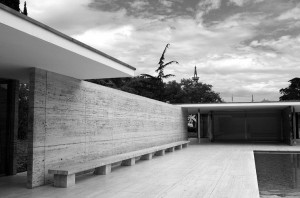Relational logics helped shape the critical analysis of the Barcelona Pavilion. There are 3 fundamental aspects that describe the relationship between the existing resources of the site, their environment, thus their response to built form.
First, the existing resources can be found within the Context which includes vegetation and landform. Function and Aesthetics respond to the flat morphology, secluded area of the site within the urban framework. The former includes circulation and spatial organization.
The roof structure is supported by slender columns that make it appear like it is floating, it is also the most important part of the building giving it its hierarchical value. It is a building with glass walls which allow natural light to penetrate through.
Repetition is evident only in its horizontality whereas it is unique in style. There are framed view sets that allow occupants to circulate in a specific way.
It is made up geometrically of four squares comprising a grid structure, it is a rectangular whole made up of individual square or rectangular units with two reflecting pools, where balance is achieved through addition and subtraction of masses.
Meanwhile the latter deals with rich, natural material choices and the design of elements.
The Barcelona Pavilion appears to evoke Tranquility. Overall, can the characteristics of a place define and shape its energy?

